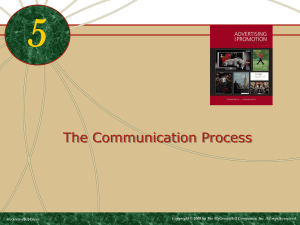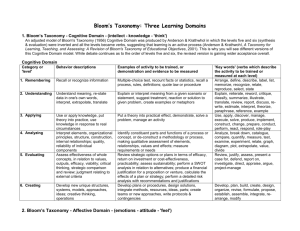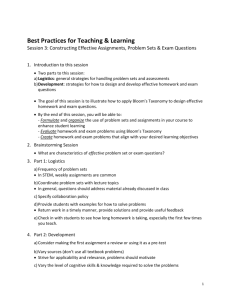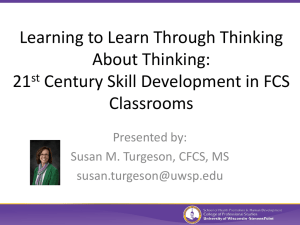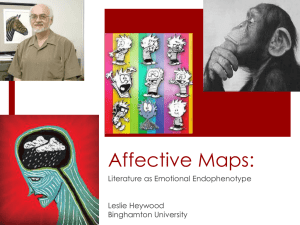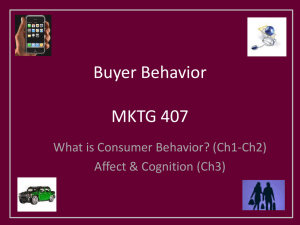Teaching through "Transforming Learning"
advertisement
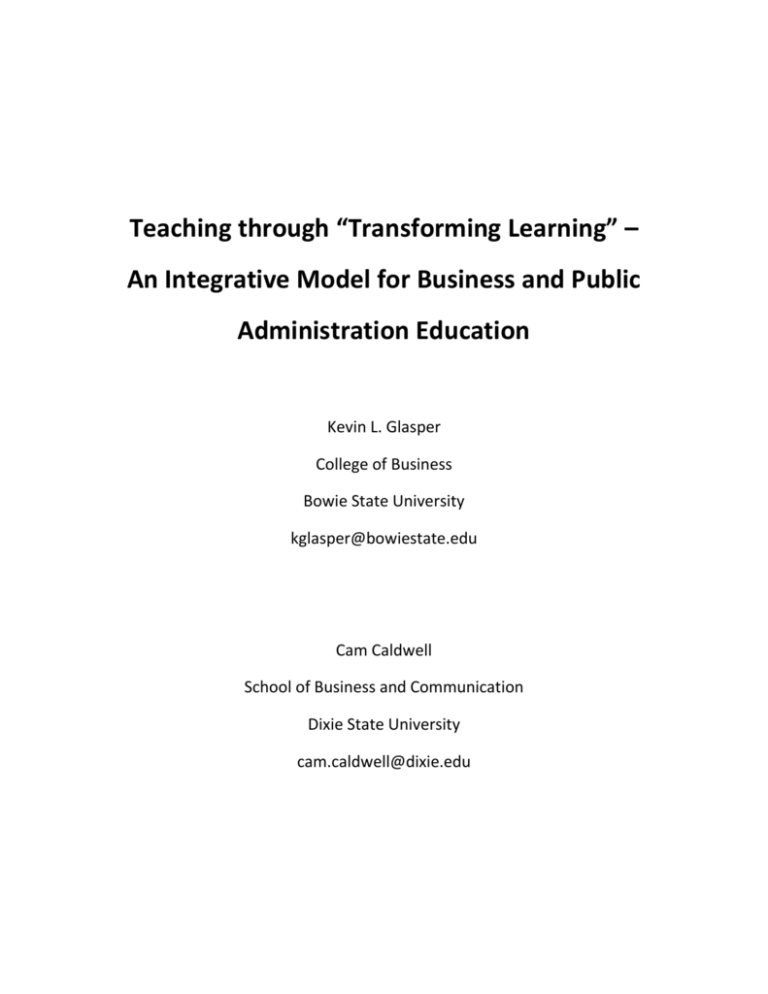
Teaching through “Transforming Learning” – An Integrative Model for Business and Public Administration Education Kevin L. Glasper College of Business Bowie State University kglasper@bowiestate.edu Cam Caldwell School of Business and Communication Dixie State University cam.caldwell@dixie.edu Abstract In this paper, we present a new model of “Transforming Learning” (TL) which incorporates key elements of cognitive, affective, conative, and applied behavioral learning that can result in enhanced student learning compared to traditional cognitively-focused teaching methods. After introducing the TL model as a resource for improving student learning, we compare this TL model with the Theory of Reasoned Action and identify how behavioral intention and the learning process are similar. We then explain the elements which make up TL and briefly describe the factors which make up the cognitive, affective, conative, and applied learning concepts which make up this model. We conclude by encouraging faculty and administrators to improve the quality of business and public administration education by adopting a TL model which enhances student learning and the application of learning concepts. Keywords: Transforming Learning, Experiential Learning, Cognitive Learning, Affective Learning, Conative Learning and Applied Behavioral Learning 2 Teaching through “Transforming Learning” – An Integrative Model for Business and Public Administration Education INTRODUCTION Kurt Lewin (1951), the noted social psychologist who had a profound impact on experiential learning, often commented that the best and most practical theories are those which can be applied. Although focusing on the application of theory is widely acknowledged as a highly-valued teaching tool by those who study learning theory (Borich, 2013), the emphasis on the application of theory is not consistently incorporated by those who teach (Zepeda, 2012) or by those who engage in managing business (Pfeffer, 1998; Phelan, 2013). In this paper we present a new model of “Transforming Learning (TL),” a teaching model that incorporates key elements of cognitive, affective, conative, and applied behavioral learning that we suggest will result in student learning that is more complete than the learning that occurs from more traditional cognitively-focused teaching methods. After introducing the TL model as a resource for improving student learning, business and public administration education, we compare this TL model with the Theory of Reasoned Action and identify how behavioral intention and the learning process are similar. We then explain the elements which make up the TL model and briefly describe the factors which make up cognitive, affective, conative, and applied learning which make up this model. We conclude by encouraging business faculty and administrators to raise the bar to improve the quality of business and public administration education by adopting a TL model which enhances student learning and the application of business and public administration concepts. LITERATURE REVIEW The Theoretical Roots of Transforming Learning Chen (2007) argued that students who have difficulty in understanding new academic concepts “do so not because of their innate abilities or intellect, but because they are struggling with conceptual transformation.” We concur with Chen and suggest that business students have difficulty in grasping business concepts that are taught in an abstract manner devoid of application in a professional or business setting. We join with those scholars who suggest that faculty in higher education can substantially improve their ability to reach their students by helping those students to conceptualize key concepts by adopting a learning approach that extends beyond a purely cognitive approach. 3 By providing a learning model that addresses the application of foundation principles as students experience the learning process, faculty can be more effective at helping students to bridge theory and application. For today’s students the task of learning a broad variety of concepts – ranging from economics, finance, and accounting to organization management, leadership, and ethics – can be a daunting experience. The ability of students to learn, integrate, and apply diverse and complex topics can be extremely difficult when, as Chen (2007) suggested, these concepts are taught primarily as abstract principles. We argue that both the traditional and contemporary management concepts above can be taught using a TL model that helps students to incorporate their basic beliefs, values and perspectives together with the application of key concepts being taught in each individual course. The TL model can best be understood in context with the process of behavioral intention, the Theory of Reasoned Action (Fishbein & Ajzen, 1975). The Theory of Reasoned Action is a theory of social psychology which explains how individuals incorporate the cognitive, affective, and conative or intentional elements in identifying cause and effect and in ultimately carrying out individual actions and behaviors (Fishbein & Ajzen, 1975; Ajzen & Fishbein, 1980). Figure One briefly presents the elements which make up the Theory of Reasoned Action. Beliefs are one’s cognitive perceptions derived from the information that an individual possesses about an object, person, or concept. Beliefs are strongly affected by attitudes, according to several scholars (Fishbein, 1963; Davenport & Prusak, 2000; Weick, 1979 & 1993) and result from the emotional responses associated with how one feels, makes sense of, or cares about and values. Intentions are one’s personal desires to carry out behaviors or actions that are congruent with one’s attitudes within a specific context or situation and may be articulated or unarticulated. The intention to act is often considered to be the best predictor of 4 one’s likelihood of behaving in a specific way, but individual actions may often fall short of one’s intentions as individuals discover that they have misread a situation, their abilities or skills, or the resources required to accomplished a desired goal (Fishbein & Ajzen, 1975). Relating the Theory of Reasoned Action to the TL process, we present Figure Two which we suggest identifies the four key elements which influence the degree to which individuals learn effectively. The TL model incorporates all four areas identified in the Theory of Reasoned Action. Cognitive learning which is so essential in understanding foundation concepts integrate with one’s affective learning insights and how each individual views relationships, values, and priorities. Cognitive and affective learning impact conative or intentional learning and enable the learner to identify what he or she must understand in the quest to translate knowledge into action. Applied behaviors enable learners to learn by practicing and refining the skills and abilities necessary to translate theories and concepts into action. Table One identifies five parallel relationships between the Theory of Reasoned Action and our TL model. 5 Table One: Parallel Elements of the Theory of Reasoned Action and Transforming Learning Parallel Factor Application to TRA Application to TL Comment Conceptual Application Explains behavioral intention Clarifies the learning process Both models describe human action in achieving desired goals Cognitive Foundation Rational behavior begins by understanding and conceptualizing key concepts or beliefs Learning requires understanding key terms, concepts, and definitions as a cognitive learning foundation Information and data are interpreted as useful or not useful to the process of achieving intended outcomes and is often selective Affective Integration Attitudes and emotion may impact how cognitive beliefs are interpreted in the sensemaking process Affective learning incorporates what is valued and cared about and includes an understanding of self and how one learns. Cognitive and affective elements combine in the process of interpreting the world and in making the transition to action Intention Determination The intention to act is based upon an interpretation of how one ought to behave and is based upon implicit moral duties Intention may involve confirming what is true or false and may involve achieving a threshold of understanding about truth as well as gathering data to improve decisions The calculus by which one creates intention involves inferences and assumptions about reality and the world in which one interacts in a constant learning process Applied Behaviors Actions and behaviors are the culmination of one’s internal process of determining how one will relate to others and the world and may be different than espoused values of actors Applied learning provides the opportunity to translate theory into actions and to develop skills or test ideas to confirm their utility The actions and behaviors of individuals may evolve as persons confirm the value of those actions in achieving intended goals 6 Although the Theory of Reasoned Action and the TL model are different in their conceptual purposes and in what they describe, both help to explain cognitive, affective, conative, and applied behaviors as they impact intended goals. The four elements of the TL model are explained below. Elements of Transforming Learning The TL model incorporates learning theories that have been articulated by a number of other scholars. Some of the learning theories are cognitive learning, affective learning, conative, and applied learning to enable business and public administration students to understand key concepts in context with their own values. Students can use those concepts and attitudes within an organizational context to understand the validity of theories in the quest to translate principles into action. Furthermore, business and public administration students can acquire the skills and abilities necessary for the practical application of concepts within specific business boundary conditions. Originally the elements of TL were first developed by Tello, Swanson, Floyd, and Caldwell, as part of their model of Transformative Learning (Tello, Swanson, Floyd and Caldwell, 2009). This paper builds upon that Transformative Learning model and reflects a more complete integration of the Theory of Reasoned Action into the learning process. McGonigal (2005) explained that effective student learning results from several required events and processes that include: 1) an activating event that exposes the limitations of a student’s current knowledge/approach; 2) opportunities for the student to identify and articulate the underlying assumptions in the student’s current knowledge/approach; 3) critical self-reflection as the student considers where these underlying assumptions came from, how these assumptions influenced or limited understanding; 4) a critical discourse with other students and the instructor as the group examines alternative ideas and approaches; and 5) opportunities to test and apply new perspectives (Kolb, 1984). McGonigal further articulates that once these activities occur then a student is likely to revise his or her schema of understanding and adopt a new paradigm and be successful at applying it (McGonigal, 2005). Our TL model incorporates each of McGonigal’s five insights and contributes to the student’s ability to successfully apply management concepts. Kolb is one of the premiere scholars in experiential learning that correlates with the transforming learning model. He argues that the experiential learning theory proceeds from a different set of assumptions and ideas that are not fixed and immutable elements of thought but they are formed and re-formed through experience (Kolb, 1984). The nexus between experiential and transforming learning is that they both include the understanding of the evolution of knowledge and learning through not just the use of theories and textbook information, but through one’s application of theory and knowledge into their values, experiences and beliefs. Cognitive Learning and Bloom’s Taxonomy For more than fifty years, Bloom’s Taxonomy and its focus on a cognitive learning pyramid have been the foundation element of learning practice in most classrooms (Bloom, 1956). Defining 7 key terms and explaining basic concepts is a necessary building block in the learning process, but is far from sufficient in preparing business students for the working world (Wineburg & Schneider, 2009). The standard Bloom’s Taxonomy model consists of the following hierarchy of learning which identifies increasingly complex levels of cognitive understanding which is a fundamental component of all student learning and a necessary but far from sufficient element in an optimal learning experience. Knowledge: Recalling previously-learned facts, terms, basic concepts, and answers, including knowledge of terminology, categories, theories, principles, and abstractions. Comprehension: Demonstrating an understanding of facts and ideas by organizing, comparing, translating, interpreting, giving descriptions, and stating main ideas. Application: Solving problems to new situations by applying acquired knowledge, facts, techniques, and rules in a different way. Analysis: Examining information by identifying motives or causes, evaluating relationships and organizing principles, and making inferences or finding evidence to support generalizations. Synthesis: Integrating information and elements in a new pattern to propose alternative solutions. Evaluation: Making accurate judgments about information, the validity of ideas, or quality of work based upon a set of criteria. Although faculty members claim that they require students to demonstrate more advanced or refined skills in Bloom’s model, fewer than twenty percent of those surveyed in a 1997 study were able to give examples of what constituted critical thinking and only 8% actually could identify criteria by which they measured the quality of student thinking (Paul, Elder, & Bartell, 1997). Element One: Defining Key Concepts, Principles, and Theories. Business concepts incorporate multiple theories and perspectives about business principles, moral duties, social and economic outcomes, freedoms, and justice. Defining these concepts requires familiarity with theories and principles about related course subject materials. As part of TL, this correct understanding of basic concepts and knowledge is foundational to their application (Bloom, 1956). Element Two: Framing Problems, Issues, and Recommendations. Understanding the economic, social, behavioral, and moral consequences of decisions on society and on other stakeholders and formulating recommendations for improved decision making are essential to understanding the implications of business actions and are major factors 8 that must be considered in teaching students about their responsibilities as leaders and managers (Hosmer, 2010). Element Three: Developing Synergistic Solutions to Create Positive Outcomes for Individuals, Organizations, and Society. Covey (2011) notes that creating such solutions is dependent upon the ability to consider implementation options that may not immediately be apparent. In today’s highly competitive work world (Christensen & Raynor, 2003), an effective business education requires students to understand and apply concepts and to propose creative, synergistic, positive solutions which demand the application of higher level cognitive skills and is critical to. TL. Business faculty often emphasize teaching concepts and ideas that emphasize the cognitive learning elements of Bloom’s Taxonomy and a focus on requiring students to learn and repeat back content material contained within a textbook (Datar, et al., 2010; Mintzberg, 2004). Chen (2007) has noted that learning concepts by rote memorization often creates conflicts within students when those concepts inherently conflict and create logical inconsistencies within students’ schema of the world. Similarly, Simon (1946) identified the “problems of administration” inherent in well-accepted management theories that often conflict but that continue to be taught in many colleges and universities as “conventional wisdom” (Pfeffer, 1998). Unfortunately, many schools emphasize to their faculty that the primary goal for faculty to pursue in order to attain tenure is to focus on becoming published in top academic journals, rather than on teaching with some schools giving new faculty to spend as little time as possible with their teaching responsibilities. In addition, doctoral programs rarely address teaching skills in the academic content of their courses and many schools incorrectly assume that subject experts in an academic discipline are automatically going to be good teachers (Berrett, 2012). As a result of the emphasis on publishing to achieve tenure and the lack of attention given to addressing teaching skills, many business faculty members deemphasize key elements of effective teaching but rely heavily on Bloom’s Taxonomy as the primary model that they rely upon in teaching. Affective Learning and Fink’s Taxonomy Attitudes and dimensions which emphasize the affective domain are integrated in Fink’s Taxonomy of Significant Learning to complement the cognitive elements of Bloom’s Taxonomy (Fink, 2003). We incorporate three elements from Fink’s Taxonomy. The first is to increase student awareness of how they learn; second, to assist students to become more selfaware(Fink, 2003); and lastly to enable students to develop critical attitudes about their own moral conduct (Piper, 1993). Affective learning outcomes which make up TL enable students to acquire insights into their individual identities and values. These affective elements of student learning encourage students to reflect on the values inherent in how they make decisions, take responsibility for their own learning, and become owners and partners in their learning process (Levine, Fallahi, Nicoll-Senft, Tessier, Watson, & Wood, 2008; Fink & Fink, 2009; Piper 1993). 9 Fink’s Taxonomy consists of six categories of learning that are “integrated and interactive rather than hierarchical” (Fink 2007). The following is a summary of the three cognitive categories of Fink’s Taxonomy and its three affective categories. Foundational Knowledge: Foundation knowledge includes the facts, principles, relationships, and theories that students must learn and remember that are associated with a subject area. Application: Application incorporates the use of appropriate information to achieve a desired outcome. Application may include the use of this information in solving a problem, making a decision, or utilizing creative thinking for an intended purpose. Integration: Integration is a skill required to identify the similarities, interactions, and key relationships between ideas, events, and theories, within a specific subject area and/or between related subject areas. Human Dimension: The human dimension involves the process of learning about oneself and/or how to interact with others. It includes understanding the process of achieving self-awareness and recognizing its importance in creating relationships to achieve desired goals. Caring: Caring involves identifying one’s feelings, opinions, values, or interests in relation to a subject or person in making normative and instrumental decisions associated with choices and alternatives. Learning How to Learn: Learning how to learn encompasses understanding and refining learning skills, including the ability to gather information, research key ideas, and continue to learn over one’s lifetime. Fink (2003) emphasized that his model incorporated cognitive elements of Bloom’s model but integrated the cognitive with affective elements that are also critically important in the learning process. Fink (2003) explained that the learning process incorporated greater selfawareness, a commitment to understanding the importance of values, and the importance of continuous learning in achieving significant learning. The following are the next three elements of TL that we have adopted from Fink’s Taxonomy. Element Four: Learning How to Learn and Research. Learning how to research key ideas, to communicate what has been learned effectively, and to adopt a personal commitment to continuous learning are fundamental to Fink’s model. This commitment to learning includes seeking out insights independently, rather than simply relying upon the information dispensed by an instructor within a course (Fink, 2003). 10 Element Five: Understanding One’s Own Identity and Values. Understanding one’s values and articulating a personal identity are essential to a clearly articulated personal identity that is translated into a capacity for high achievement and a sense of purpose toward others in society. Element Six: Developing a Value-Based and Principle-Centered Philosophy of Life. This element in Fink’s taxonomy emphasizes the importance of individuals creating moral meaning and coherence in one’s life. Scholars have repeatedly identified the importance of developing a highly moral personal philosophy as a foundation for discovering one’s moral identity and for honoring a personal moral code or conscience (Covey, 2004; Paine, 2003; Hosmer, 2011).i These three elements of TL affirm the importance of the affective domain in student learning and reinforce the importance of business faculty delivering learning experiences that enable students to learn how to learn, reflect upon and consciously identify their values, and develop a philosophy of life that guides them in decision-making and in their relationship with others. Conative Learning and Transformational Learning A conative action is one that transforms thoughts and feelings into an intended course of action and conative learning centers on identifying factors that are barriers to be overcome in the quest to achieve positive change. TL emphasizes the conative application of ideas and is a learning model that integrates the cognitive with the affective to achieve personal and organizational excellence (Mezirow, 2000). Based upon what Mezirow (2000) described as “Transformational Learning,” the conative element of TL emphasizes individual learning within an organizational context and encourages learners to assess previous paradigms and assumptions—modifying mental models when those models are ineffective in optimizing performance (Boyd & Myers, 1988). Mezirow explained that Transformational Learning required that individuals confirm or disconfirm what is and is not true (cf. Schein, 2010; Weick, 2009). Tello and colleagues (2013) noted that Transformational Learning is: 1. Self-directed and voluntary after learners have acquired the foundations skills about a particular subject area (Knowles, 1975 & 1980). 2. Problem-oriented and practical about issues that have application within a real world context (Cranton, 2006). 3. Action-oriented in enabling learners to follow a course of conduct that promotes personal growth (Mezirow, 1991). 4. Collaborative and participative in engaging participants in addressing similar or shared experiences (Cranton, 2006). 11 These qualities mesh with the Theory of Reasoned Action’s emphasis on intentionality in action in accomplishing a needed change that builds on but goes beyond the cognitive and affective dimensions of learning and individual behavior (cf. Cranton, 2006). The following are the three conative elements of TL that we have adapted for our proposed model of TL. Element Seven: Confirming or Disconfirming whether Past Truths are Valid. The capability to examine whether previously held theories are correct and to discern their applicability within specific conditions are skills which require a willingness to think deeply and suspend assumptions about the truth. These skills are critical for both personal growth (Arbinger Institute, 2002) and business success (Pfeffer, 1998; Pfeffer & Sutton, 2007). Element Eight: Identifying How Learning Thresholds can Create Learning Insights and Provide Clarity. The ability to test assumptions about previously believed ideas requires the achievement of a level of knowledge or a threshold view of reality that makes it possible to adopt new insights that add value. This ability is a fundamental element of personal growth and organizational innovation and meaning (Meyer, Land, & Baillie, 2010; Novak & Gowin, 1984). Element Nine: Creating an Ethical Framework for Making Decisions and Weighing their Costs and Benefits. Achieving superior outcomes requires a decision-making model that includes evaluating the costs and benefits associated with goals that balance the creation of long-term financial success with ethical, political, and other important social considerations (Hosmer, 2010; Paine, 2002; Swanson, 1999). Individuals ultimately base their intended actions upon a foundation of implicit or explicit ethical assumptions that build upon their beliefs and attitudes. These three elements of conative or Transformational Learning focus student learners on understanding the realities of that which can really work and be applied. Distinguishing between “conventional wisdom” which can be the cause of many organization dysfunctions (Pfeffer, 1998) and valid theory is a critical capability that business students and practitioners need to develop in order to be effective in today’s complex business world (Phelan, 2013). The ability to confirm or disconfirm what is and is not valid and to properly understand and utilize information is a struggle that business leaders have wrestled with for decades (cf. Deming, 2000). Applied Behaviors and Actions 12 Piper (1993) emphasized that the application of knowledge was the greatest value of education. Business success ultimately depends upon the behaviors and actions of individuals and organizations, and the best measure of one’s ability to learn is in how they actually apply that learning, as measured by their actual actions and behaviors. The integration of cognitive beliefs, affective attitudes, and conative or transformational intentions must be translated into actual behaviors, performance, and actions for the learning process to be optimally successful for employers and other cooperative relationships (Fishbein & Ajzen, 1975 & 2009). The following are the three elements of applied or behavioral learning that are included in our TL model. Element Ten: Learning by Doing. Applied learning incorporates key elements of skill and ability development that result from practicing and polishing applied knowledge. Learning by doing can be achieved by participating in internships, service learning, completing work simulation assignments, and other learning activities that enable learners to actually perform required behaviors that are similar or identical to those that are carried out in a real world context (Kolb, 1984). Element Eleven: Incorporating Social Intelligence. Social intelligence is the behavioral skill of responding appropriately in complex social situations in a manner that strengthens and enhances relationships (Albrecht, 2007). Social intelligence is a key behavioral quality required in virtually every business context and requires that an individual demonstrate self-awareness, personal self-monitoring and control, empathy toward others, and the adaptive capacity to respond appropriately and effectively in dealing with others (Goleman, 2007). Element Twelve: Demonstrating Constant Improvement. The capacity to constantly learn and improve and to translate that learning into action is a distinguishing skill of great individuals and organizations (Senge, 2006). The capacity to search for and to create new insights and innovations is an essential skill for organizations to sustain competitive advantage (Christensen & Raynor, 2003). TL creates a learning culture that empowers students to constantly search for new insights and that asks them to apply those insights in the learning process (cf. Pava, 2003; Covey, 2004). These twelve elements that make up TL challenge students to go far beyond learning the factual and informational content of business and public administration courses, although they include those important foundation requirements. The ultimate focus of TL is to enable learners to discover new ways of enhancing their capacity to become better informed, more responsive to the needs of changing situations, and more capable of helping themselves and others to achieve their potential. By including affective, conative, and applied behavioral learning principles, TL focuses students on understanding the behavioral, interpersonal, value-based, and ethical elements of course content. Furthermore, the TL model encourages students to challenge assumptions and theories, confirm or disconfirm facts empirically, and achieve a threshold of understanding that 13 enables students to become better students and more effective scholars and practitioners, and to develop the skills and abilities required to actually apply knowledge. CONCLUSION Insights for Application In his insightful book about significant learning, L. Dee Fink (2003) explained that those who teach in higher education are willing to change their style of teaching under four conditions: 1) they become aware of ways of teaching that are significantly different than the methods that they currently use; 2) they believe that good things will happen if they change their learning approach; 3) they understand how to teach in new and different ways; and 4) their institutions recognize, encourage, and support their efforts to improve their teaching. Fink has addressed a reality-based explanation of why many faculty choose not to modify their teaching styles from traditional, cognitively-based, multiple choice exam measured teaching. The Challenge We acknowledge that the TL model described herein may require faculty to make difficult teaching changes and may require them to think more deeply and work with greater effort to engage and assist their students to learn. Furthermore, we recognize because all students do not come from the same educational, social and economic and political backgrounds, some students will have limited experiences that they bring to the classroom and may struggle in their ability to learn and apply TL concepts as quickly as others. Despite these realities, we encourage faculty to use this teaching model because we find its key elements to be rationally sound and more effective at enabling students to learn and apply key business and administrative concepts. Future Research Moreover, we have found by personally applying its teaching methods that it also has profound positive benefits for students in the classroom in terms of their understanding of business and administrative concepts and principles. In preliminary efforts to apply the TL model in teaching business classes, we have seen business students’ level of understanding of business concepts increase, as well as their personal self-awareness about themselves and their own values, in addition to seeing students improve their ability to apply business concepts in internships and consulting projects. Further research is needed, of course, to test the TL model in a variety of classroom and applied contexts. We encourage business faculty members to examine the importance of affective, conative, and applied features of TL in context with their own teaching style, rather than relying entirely on cognitive teaching. We suggest that faculty who seriously examine this TL model will quickly recognize the model’s ability to improve the quality of education provided to students--the future leaders upon whom our children, grandchildren, and society will ultimately depend for business and economic success. 14 References Berrett, D., (2012). Harvard Conference Seeks to Jolt University Teaching, The Chronicle of Higher Education, http://chronicle.com/article/Harvard-Seeks-to-Jolt/130683/ Accessed 2/05/12. Borich, G. D., (2013). Effective Teaching Methods: Research-Based Practice (8th Ed.). New York: Pearson. Boyatzis, R. E., and McKee, A., (2005). Resonant Leadership: Renewing Yourself and Connecting with Others through Mindfulness, Hope, and Compassion. Boston, MA: Harvard Business School Publishing. Burke, C. A., (2009). “Mindfulness-Based Approaches with Children and Adolescents: A Preliminary Review of Current Research in an Emergent Field.” Bangor, UK: Center for Mindfulness Research and Practice Occasional Paper. Caldwell, C. (2009). “Identity, Self-Deception, and Self-Awareness: Ethical Implications for Leaders and Organizations.” Journal of Business Ethics, Vol. 90, Supp. 3, pp. 393-406. Cameron, K. S., (2003). “Ethics, Virtuousness, and Constant Change” in N. M Tichy and A. R. McGill (Eds.) The Ethical Challenge: How to Lead with Unyielding Integrity. San Francisco, CA: Jossey-Bass, pp. 186-194. Chen, J. C. (2007). “Application of Transformative Learning Theory in Engineering Education.” 1st International Conference on Research in Engineering Education, Honolulu, HI, June 22-24, 2007, pp. 1-6. Christensen, C. M., and Raynor, M. E., (2003). The Innovator’s Solution: Creating and Sustaining Successful Growth. Boston, MA: Harvard Business School Press. Covey, S. R., (2004). The 8th Habit: From Effectiveness to Greatness. New York: Free Press. Covey, S. R., (2011). The 3rd Alternative: Solving Life’s Most Difficult Problems. New York: Free Press. Datar, S. M., Garvin, D. A., and Cullen, P. G., (2010). Rethinking the MBA: Business Education at the Crossroads. Boston, MA: Harvard Business School Publishing. Fink. L. D., (2003). Creating Significant Learning Experiences: An Integrated Approach for Designing College Courses. San Francisco, CA: Jossey-Bass. Fink, L. D. (2007). “The Power of Course Design to Increase Student Engagement and Learning.” Peer Review, Vol. 9, Iss. 1, pp. 13-17. 15 Fink, A. K., and Fink, L. D., (2009). “Lessons we Learn from the Voices of Experience.” New Directions for Teaching & Learning, Vol. 119, pp. 105-113. Fishbein, M, and Ajzen, I., (1975). Belief, Attitude, Intention, and Behavior: An Introduction to Theory and Research. Indianapolis, IN: Addison-Wesley. Fishbien, M., and Ajzen, I., (2009). Predicting and Changing Behavior: The Reasoned Action Approach. New York: Psychology Press. Friedman, T. L., (2009). Hot, Flat, and Crowded: Why We Need a Green Revolution – and How it Can Renew America, Release 2.0. New York: Picador. Goleman, D., (2007). Social Intelligence: The New Science of Human Relationships. New York: Bantam Publishing. Hosmer, L. T., (2010). The Ethics of Management: A Multidisciplinary Approach (7th edition). New York: McGraw Hill/Irwin. Kolb, D.A., (1984). Experiential Learning: Experience As the Source of Learning and Development. New Jersey: Prentice-Hall, Inc. Levine, L. E., Fallahi, C. R., Nicoll-Senft, J. M., Tessler, J. T., Watson, C. L., and Wood, R. M., (2008). “Creating Significant Learning Experiencess across Disciplines.” College Teaching, Vol. 56, Iss. 4, pp. 247-254. Lowenstein, R., (2010). The End of Wall Street. New York: Penguin Press. Lowenstein, R., (2008). While America Aged: How Pension Debts Ruined General Motors, Stopped the NYC Subways, Bankrupted San Diego, and Loom as the Next Financial Crisis. New York: Penguin Press. McGonigal, K. “Teaching for Transformation: From Learning Theory to Teaching Strategies,” Stanford University Center for Teaching and Learning Newsletter, Vol. 14, No. 2, 2005. (Available on the web at http://ctl.stanford.edu/Newsletter/). Merriam, S. B., (2004). “The Role of Cognitive Development in Mezirow’s Transformational Learning Theory.” Adult Education Quarterly, Vol. 55, Iss. 1, pp. 60-68. Mezirow, J., (Ed.). (2000). Learning as Transformation: Critical Perspectives on a Theory in Progress. San Francisco, CA: Jossey-Bass. Meyer, J. H. F., Land, R., and Baillie, C., (Eds.) (2010). Transformational Learning. Boston, MA: Sense Publishers. 16 Threshold Concepts and Mintzberg, H. (2004). Managers not MBAs: A Hard Look at the Soft Practice of Managing and Management Development. San Francisco, CA: Berrett-Koehler. Paine, L. S., (2002). Value Shift: Why Companies Must Merge Social and Financial Imperatives to Achieve Superior Performance. New York: McGraw-Hill. Paul, R., Elder, L., and Bartell, T., (1997). California Teacher Preparation for Instruction in Critical Thinking: Research Findings and Policy Recommendations. Sonoma, CA: Foundation for Critical Thinking. Pava, M., (2003). Leading with Meaning: Using Covenantal Leadership to Build a Better Organization. New York: Palgrave Macmillan. Pfeffer, J., (1998). The Human Equation: Building Profits by Putting People First. Boston, MA: Harvard Business School Press. Pfeffer, J., and Sutton, R. I., (2007). “Suppose We Took Evidence-Based Management Seriously: Implications for Reading and Writing Management.” Academy of Management Learning & Education, Vol. 6, Iss. 1, PP. 153-155. Phelan, K., (2013). I’m Sorry I Broke Your Company: When Management Consultants are the Problem, Not the Solution. San Francisco, CA: Berrett-Koehler. Piper, T. R., (1993). “Rediscovery of Purpose: The Genesis of the Leadership, Ethics, and Corporate Responsibility Initiative” in T. R. Piper, M. C. Gentile, & S. D. Parks (Eds.) Can Ethics be Taught? Perspectives, Challenges, and Approaches at Harvard Business School, Boston, MA: Harvard Business School Press, pp. 1-12. Simon, H. A., (1946). “Proverbs of Administration.” Public Administration Review, Vol. 6, No. 1, pp. 53-67. Smart, K. L, Witt, C., and Scott, J. P. (2012). “Toward Learner-Centered Teaching: An Inductive Approach. Business Communication Quarterly, Vol. 75, No. 4, pp. 392-403. Swanson, D. L., (1999). “Toward an Integrative Theory of Business and Society: A Research Strategy for Corporate Social Performance.” Academy of Management Review, Vol. 24, Iss. 3, pp. 506-521. Tello, G., Swanson, D., Floyd, L., and Caldwell, C. (2013). “Transformative Learning: A New Model for Business Ethics Education.” Journal of Multidisciplinary Research, Vol. 5, No. 1, pp. 105-120. Wineburg, S., and Schneider, J., (2009). “Was Bloom’s Taxonomy Pointed in the Wrong Direction?” Phi Delta Kappan, Vol. 91, Iss. 4, pp. 56-61. 17 Zepdea, S. J., (2012). Instructional Supervision: Applying Tools and Concepts. New York: Routledge. 18
